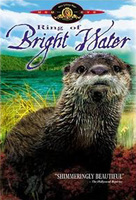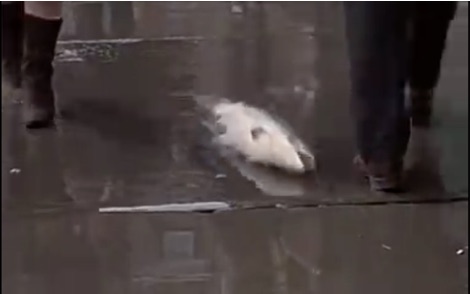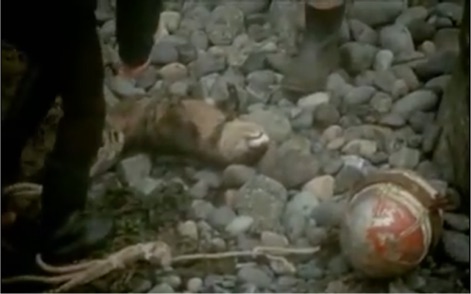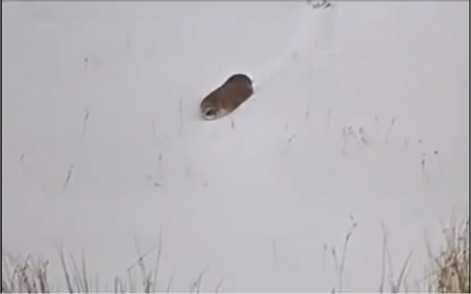
“He was boneless, mercurial, sinuous, wonderful… he was an otter in his own element and the most beautiful thing in nature I had ever seen.” [1]
The 1960s seems littered with autobiographical accounts of human and animal relations which are, as a result of the popularity of the novel, projected upon the platform of film. Bill Travers and Virginia McKenna acted as figureheads for the new wave of naturalists that these films inspired, as they starred in some of the largest films of this ilk, such as Born Free, An Elephant Called Slowly and Ring of Bright Water. The latter of these is based upon Gavin Maxwell’s 1960 autobiographical work of the same same, with the above quote taken from the novel. The film sees a change in the lead characters name to Graham, however we similarly follow him to an isolated residence on the West Coast of Scotland with the company of an otter, just like the book. We see the attempts of man and animal to co-habit being explored to both comic and emotional ends. The pair struggle in the early exchanges of the film, however following Mij’s escape and resulting harm, a more reserved Mij emerges. Upon the surface a ‘humanisation’ of the otter could be perceived, however the film suggests differently. The problematic terms of ‘animalisation’ and ‘humanisation’ enforce the imposition of the human as supreme and ignore a friendship of shared equal worth. The film shows animal identity as a human construct, an idea that once broken down, allows for the growth of the human-animal friendship. Within Graham’s Edenic Scotland the animal does not embody any human interpretation of its being, as, “Mij doesn’t know he’s an otter.”[2]
Stylistically, the film is interspersed with recounts of Graham’s diary that act as soliloquies, allowing the viewer to delve deeper into the relationship. It is pressing that within the friendship, we only hear from the human, as this acts to reinforce the dominance of a pet-like relationship. However, the film acts to distance itself from this interpretation, shifting the relations into a sphere of friendship by critiquing the human. The film suggests that the animal and human can communicate, yet not through the human construct of spoken language that we are accustomed to. It is Jonnie the dog (owned by Dr. Mary) who points them in the direction of Mij after his escape, not through unnatural means, but simply a human interpretation of another species’ intelligence. This is conveyed to the audience through the human re-telling, a fact which Eleanor Sandry explores.[3] Whilst the diary asides act to detail a one-sided interpretation of the relationship between Mij and Graham, as human viewers we can only ever expect a one-sided account of a human-animal friendship, and asking for more goes beyond a respect for the boundaries of species, with these boundaries presented as intrinsic to the friendship.

(figure. 1)
Whilst Mij acts as our hero and central animal figure, it is the presence of the fish that plays an equally important role. The film places fish as a subspecies, below both human and otter, however their importance in the story is pivotal to the narrative. Firstly, it is only through a fish, albeit a dead one, that Graham encounters Mijbil in the pet store window, as it entertainingly escapes from his grasp and slides along the pavement towards the shop (figure.1). Throughout, the fish, or aquatic animal, is used for comic effect; we see Graham flipped out of his boat by a basking shark. Slapstick comedy in the film panders to child viewers, yet this slapstick is important to gauge attention and present the commentary upon the importance of a respect for nature to the younger audiences. However, if the fish is employed to shuffle along the plot, and as a counterpart to the comedy which draws in the next generation of conservation workers, the film does not applaud the animal itself. Whereas other animals are respected for their inherent attributes, the fish’s sole purpose is to benefit the human or, equally, the otter. The basking shark supports this hierarchy in the film, with the fish below both man and otter, and enforces the common strand of an adherence to the natural. The hunt of the shark succinctly depicts the ineffectiveness of the human in the animal sphere. Graham himself states in an aside:
“I often spent several hours a day catching fish, or trying to… As i watched I began to see them [basking sharks] in a new light, there in view was a whole years supply of shark steaks.”
The failure of his hunting is foreshadowed in the comedy of the scene. After eventually killing a shark, it is revealed that Mij does not like shark steaks. Graham’s failure to provide for the animal in an ‘animalistic’ way highlights the film’s commentary upon the respect that must be paid animals, but equally that humans must respect their own human nature.
The friendship truly matures following what could be termed the ‘volta’ of the film. The human ‘hunts’ in a way much more familiar, being for a fish at a market and with money. This adherence to human characteristics rather than emulating an otter’s is what develops the friendship, and the film reflects this. Similarly, this market scene runs parallel to Mij escaping and subsequently being caught and hurt by a buoy. We are briefly shown a lifeless Mij upon the beach, condemning our human need to anthropomorphise the animal or ‘animalise’ the human in order to construct a level platform for a friendship, manifested in a lifeless otter.

(figure. 2)
Consequently, in not posing the animal and human as two opposites, the pejorative connotations of what is it to be ‘animal’ are removed. Barbara Smuts explores the need to “recognise and relate to the animal as an individual”, suggesting that in doing so we pay respect to the animal’s behaviours, and in turn similarly acknowledge the attention the animal pays to ours.[4] The film similarly supports this, by contrasting before and after the incident. However, if to anthropomorphise is to not respect the animal as an individual, how can we ever interpret the actions of an animal if the only means we have is through the human gaze, and by human interpretation? The film and Smuts are both in agreement that it is anthropomorphism that is problematic, through its suggestion of the supreme human. Smuts recognises that animals are “social subjects”, who in turn are just as likely to experience language, trust and respect.[5] Therefore, when we see Jonnie sat upon a chair, instead of drawing the easy connection of his want to become human, we should instead regard it simply as an act, neither human nor animal. Rather than mapping the human upon the animal, or taking the animal characteristics upon ourselves, the humanly constructed negative connotations of being ‘animal’ are removed, and the simpleness of a friendship can be established. The film shows that a dog may just want to sit upon a chair, just as readily as an otter might want to play in the snow.

(figure. 3)
Ring of Bright Water, then, can be seen to give us an Eden, where human and animal construct a friendship bereft of tension in their acceptance of the other’s characteristics. Maxwell himself regarded the year spent with Mijbil as a ‘lost paradise’, as the film is true to the novel in its upsetting conclusion of Mij’s death. The film presents Eden as a fleeting moment, reflecting Maxwell’s statement about his experience.
The semi-aquatic nature of Mij is vital, as a simplistic reading suggests it is his closeness to the human that allows him to develop, placing him above fully aquatic animals. The fishes and shark act to move the narrative, yet do not experience the same respect which is paid to Mij. Interpreting this suggests that the friendship flourishes between otter and man as the otter is more ‘humanised’. However, such a reading is a regression away from what the film wholly suggests. Instead, the film is so true to this ‘animalism’ that it respects the natural order of a food chain, with the fish naturally being below the otter. Therefore, through the subjugation of the fish, we consequently are given an Edenic harmony, one of a food chain and a hierarchy, establishing a natural order within the film. This harmony is one that must be respected, however fleetingly, if we are to experience Graham and Mijbil’s Eden. Therefore, the breaking of boundaries between human and animal, which mould the friendship, are a direct result of a respect for these very boundaries.
This realism in the communication of the human and animal juxtaposes many animation films, in particular those by Disney, where communication is through the human language. Reinforcing Barbara Smuts’ argument, this representation of anthropomorphism common in animation acts to undermines the animal’s own nature. The conservation success of Ring of Bright Water and Born Free lies in the respect paid to the animals’ own nature, and the failures in attempts to construct a ‘humanised’ animal. Just as Born Free shows us the failings of raising a lion within the confides of a humanised sphere, Ring of Bright Water depicts that the human must respect both the human nature and the true animal nature, not the human-construction of an animal’s identity.
References:
[1] Gavin Maxwell, Ring of Bright Water (London: Penguin Books, 1996), p. 145.
[2] Daniel Allen, Otter (London: Reaktion Books, 2010) p. 121.
[3] Elenor Sandry, ‘Human-Animal Communication’, in Robots and Communication, ed. by Elenor Sandry(Basingstoke: Palgrave Macmillan, 2015) p.33.
[4] Barbara Smuts, ‘Between Species: Science and Subjectivity’, Configurations, 14.1-2, (2006), 115-126 (p. 125), in Project Muse <http://muse.jhu.edu/journals/con/summary/v014/14.1.smuts.html> [accessed 20 January 2016].
[5] Barbara Smuts, ‘Living with Animals’, in Lives of Animals, ed. by J. M. Coetzee (Princeton: New Jersey, 1999), p. 118.
[6] Marcus Field, ‘Gavin Maxwell’s bitter legacy: Was the otter man the wildlife champion he appeared to be?’, The Independent (2014) <http://www.independent.co.uk/news/people/profiles/gavin-maxwells-bitter-legacy-was-the-otter-man-the-wildlife-champion-he-appeared-to-be-9595629.html> [accessed 21 January 2016].
Bibliography
Primary Text
Ring of Bright Water. Dir. Jack Couffer. Cinerama Releasing Corp., 1969.
Secondary Texts
Allen, Daniel, Otter (London: Reaktion Books, 2010)
Field, Marcus, ‘Gavin Maxwell’s bitter legacy: Was the otter man the wildlife champion he appeared to be?’, The Independent (2014) <http://www.independent.co.uk/news/people/profiles/gavin-maxwells-bitter-legacy-was-the-otter-man-the-wildlife-champion-he-appeared-to-be-9595629.html> [accessed 21 January 2016]
Maxwell, Gavin, Ring of Bright Water (London: Penguin Books, 1996)
Sandry, Elenor, ‘Human-Animal Communication’, in Robots and Communication, ed. by Elenor Sandry(Basingstoke: Palgrave Macmillan, 2015)
Smuts, Barbara, ‘Living with Animals’, in Lives of Animals, ed. by J. M. Coetzee (Princeton: New Jersey, 1999)
Smuts, Barbara, ‘Between Species: Science and Subjectivity’, Configurations, 14.1-2, (2006), 115-126 (p. 125), in Project Muse <http://muse.jhu.edu/journals/con/summary/v014/14.1.smuts.html> [accessed 20 January 2016]
Further Reading
Allen, Daniel, Otter (London: Reaktion Books, 2010)
Perlin, Ross, Why would anyone want to shoot a sea otter? (2015) <http://www.theguardian.com/world/2015/mar/10/why-would-anyone-want-to-shoot-a-sea-otter>
Images
[1] Still from Ring of Bright Water (1969)
[2] Still from Ring of Bright Water (1969)
[3] Still from Ring of Bright Water (1969)